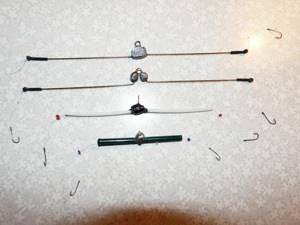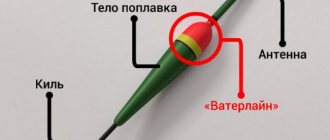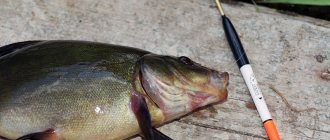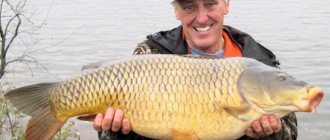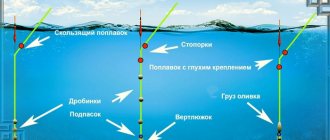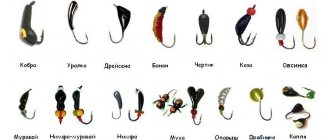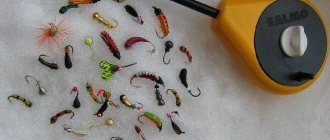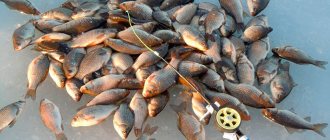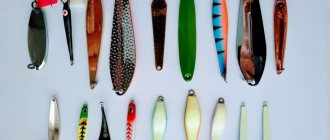How to equip a winter fishing rod for roach fishing
A winter float rod for roach is usually used in reservoirs with a complete absence of current. This tackle is effective and allows you to catch both active and passive fish.
Choosing a fishing rod
When ice fishing with a float, experienced winter fishermen prefer to use models called “filly”. Fillies have a number of advantages:
- reliability;
- ease of use;
- minimum weight.
The body of the fishing rod is made of hard foam, resistant to mechanical damage. The flexible plastic whip is reliable and dampens the first jerk of the fish after hooking.
Fishing rod filly
Thanks to its successful design, the fishing rod stands securely on the ice. The “filly” has a high profile, which makes it possible to quickly pick it up when biting. This roach fishing rod in winter does not have small parts that freeze and interfere with its functionality.
Line selection
In clear winter water, roaches show increased caution, so attention is paid to the thickness of the fishing line and the material from which it is made. For ice fishing, monofilament threads are used, aimed at fishing in cold weather. Their advantages include:
- shock-absorbing qualities;
- strength;
- stealth in water;
- ease of use at low temperatures.
Monofilament fishing line has a high elongation coefficient and absorbs the jerks of the fish when playing. This is important when fishing for large roach . Monofilament has a high breaking load, which makes it possible to use monofilaments of small diameter. Almost complete invisibility in the water makes the monofilament interchangeable for ice fishing. This material does not absorb moisture and maintains performance at low temperatures.
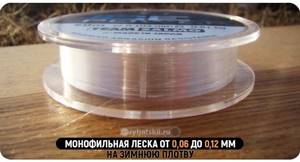
Use monofilament line no thicker than 0.12 mm
The diameter of the fishing line is set to 0.12 mm. In the deep winter roach, when the food activity of the fish is low, this figure is reduced to 0.06 mm. Thick monofilaments sharply reduce the number of bites.
Float selection and design
A float is an element of equipment on a winter fishing rod for catching roach, allowing the angler to observe the stages of the bite. This element consists of several parts:
- housing made of hard foam;
- a hinged wire structure, which serves to attach the float to the main fishing line;
- silicone cambric.
To attach the bite alarm to the monofilament, the fishing line is threaded into a silicone cambric, and then a wire structure located at the bottom of the float is inserted into it. This method of fixation will allow you to quickly change the depth when moving to a new hole.
Fishing for roach in winter is carried out at a depth of no more than 3–6 meters, so the carrying capacity of the float does not exceed 1.5 grams. Large floats reduce the sensitivity of the equipment. For visibility, the upper part of the float is painted in bright colors. During the fishing process, the float is submerged by 3–4 cm.
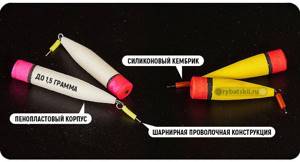
Winter float for roach
In mid-winter, roaches often bite 1–1.5 m from the bottom. In this case, use the summer version of the float, which is used for fishing bleak and has a load capacity of 0.2–0.5 g.
Loading float gear in winter
Correct loading of the float will ensure the sensitivity of the tackle and allow you to see even the most careful bites. The bulk of the sinkers are concentrated 70–80 cm from the hook. A small feed pellet is installed at the connecting leash loop.
This method of loading is suitable for catching roach on a float in winter in still water. When biting, the roach easily lifts the feeding pellet from the bottom. The fisherman sees this action as a bite alarm rising to the surface.
Use of leashes
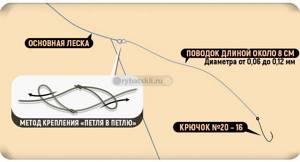
Scheme for tying a leash using the loop-to-loop method
The equipment of a winter float fishing rod for fishing includes a leash. This element is a piece of monofilament fishing line to which a hook is attached. Its diameter depends on the expected size of the prey and ranges from 0.06 to 0.12 mm.
The length of the leash when equipped with a winter fishing rod for roach is 8–10 cm. It is attached to the main line using the “loop-to-loop” method, which allows you to quickly replace it if the hook breaks.
It is better to prepare leashes of various diameters at home in advance. For fishing, hooks No. 20–16 are used (according to the international classification).
Ice fishing float

Floats for winter fishing can be classified by design and method of attaching the float to the fishing line.
Types of winter floats

By mounting method:
According to the method of fastening, winter floats are divided into removable and non-removable. The latter are now very rarely used; the line of a winter fishing rod passes through the body of the float. Such a float can only be replaced together with all the equipment.
Removable floats are fixed to the fishing line at one point using a cambric or PVC tube. The removable float is fixed using a plastic or metal pin (clamp) made of wire located in the lower base of the float. The latch itself is attached to the float not rigidly, but loosely, in a loop-to-loop manner.
By design:
- Classic cylindrical or round float;
- A cylindrical float beveled at the top;
- Double float;
- Winter float “Tablet”;
- Drop-down petal float;
- Flower float.
The last two types of floats are rarely used in winter fishing and can be classified as exotic.

Pop-up float
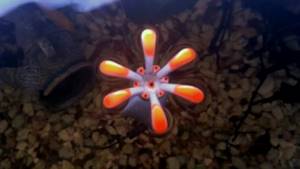
Flower float
Float petal and flower
As we have already said, a winter float with petals is a complicated design of a regular float. The purpose of this complication is to better visualize the moment of the bite.
The petal float consists of two halves of a regular cylindrical float, each of which has a loop for connection to the float retainer. After making such a float, it is necessary to adjust the correct opening of the float after surfacing.
A flower float is an impressive, but more complex design, which, if desired, can also be made with your own hands. We have not seen such floats in the assortment of fishing stores.
Technique for catching roach in winter using a float
Correct installation of a winter float fishing rod on a sorog affects the results of fishing. However, for successful fishing it is worth talking about the intricacies of the technique of ice fishing for roach.
How to choose a fishing spot

Look for depressions and snags in the pond
Arriving at a pond, the angler must immediately find a fishing spot. At the very beginning of freeze-up, schools of roach and roach feed at a depth of about 2.5 meters. At this time they are looking for fish:
- in coastal pools;
- in shallow local pits;
- in snarled areas of the reservoir.
Towards the middle of winter, the roach moves to areas with depths of 4–6 meters. In January and February, this species is found near wintering pits, as well as on large stretches with a flat bottom.
With the arrival of spring and fresh water entering under the ice, flocks of sorogs begin to move around the reservoir and can peck in a variety of places. At this time, roach is often caught not at the bottom, but in the middle layers.
Choosing a bait and feeding

Working baits
The effectiveness of fishing also depends on the choice of bait and bait. In winter, roaches bite well on bloodworms. In addition to this traditional bait, the following types of baits are also used:
- burdock moth larva;
- maggot;
- muckworm.
In some reservoirs, the sorog readily responds to dough and semolina mixed with beef blood. To fish for roaches that live in sea estuaries, fresh shrimp meat is used as bait. In case of sluggish bite, it is recommended to treat the bait with “dips”.
Bait helps attract fish to the fishing point and increases the number of bites. Since winter roach fishing with a float is carried out in reservoirs with no current, dry bait mixtures are usually poured directly into the hole.
The classic winter bell-type feeder is used only when fishing on flowing lakes and reservoirs, and also if the depth at the fishing site is more than 5 meters. An attractive winter mixture for sorogha has the following characteristics:
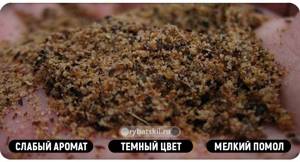
The main qualities of bait
- dark color;
- finely ground;
- weak aroma.
The composition includes animal components in the form of food bloodworms or small maggots. Starter feeding is about 150 grams of dry mixture per hole. If the fish is highly active, provide regular supplementary feeding in 50 gram portions.
Fishing process
Having arrived at the reservoir, the angler drills 2-3 holes at a distance of 10-15 m. It is good if the depth at the selected points varies. The next stage is feeding the drilled holes. During the day, the fisherman alternately fishes bait points. If the bite in one place has weakened, it is better to immediately move to another and let the hole “rest”. While fishing, make sure that the bait remains fresh and mobile - this will increase the quality and quantity of bites. It is advisable to change such a delicate bait as bloodworms after each catch of fish. The maggot does not require such frequent replacement.
Read how to properly attach a bloodworm so as not to damage the bait.
If there is no fish activity, it is useful to lift the bait from the bottom and swing the tip of the rod for a few seconds. This action will allow the roach to notice the bait faster and often provokes it to bite.
How to detect a bite and hook
The nature of roach bites directly depends on its feeding activity at the time of catching and is divided into 3 types:
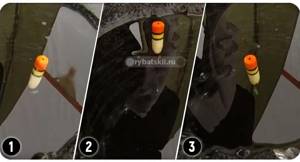
Three types of bites
- the float floats to the surface;
- the signaling device goes to the side;
- The float moves slightly in one place.
When the roach shows increased activity, the bite looks like a sharp ascent or the float moving to the side. You need to cut right at this moment. If the fish is passive, then there are no significant changes in the behavior of the float when biting. The alarm may move slightly or barely noticeably move from side to side, but nevertheless, after hooking the sorog, it gets hooked.
Ice fishing
Along with active jigs, stationary ice fishing with fishing rods is probably the most common method of winter fishing. The choice of fishing method depends on the characteristics of the reservoir and the local traditions of fishermen. A pattern is clearly visible - in some places the majority of ice fishermen prefer jigs for play, in others they prefer “sedentary” fishing with rods.
- If the emphasis in jigs is on active search and movement, then in stationary fishing with rods the emphasis is on initially strategically choosing the right place and time with a competent feeding system.
- In many ways, the success of stand-up fishing is determined by bait and bait. However, this does not mean that fishing rods on the spot for winter fishing is a passive activity. Active search is also used - it’s just that the overall speed of the fisherman’s movements is noticeably lower.
- Each feeding point is carefully fished with fishing rods - it takes time for the feeding to collect the fish, sometimes more than an hour. If it doesn’t bite, then the fisherman moves on. You shouldn’t sit on one hole all day if you don’t bite at all.
Read more about the tactics and techniques of fishing with winter fishing rods.
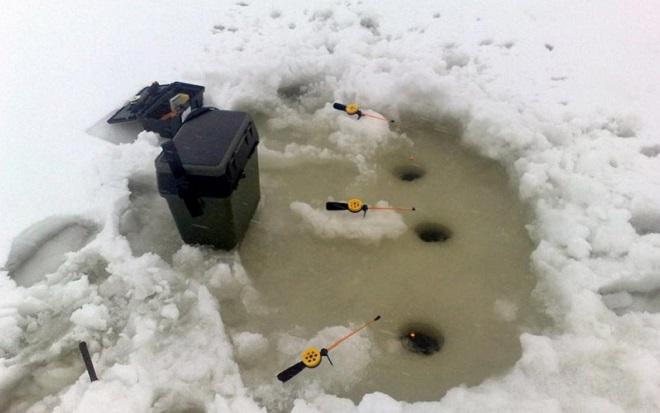
Fishing rod for catching roach in still water without a float
Winter float tackle for roach is used if the fish prefers to peck at a bait lying motionless on the ground. When the sorog feeds just above the bottom, the best results are shown by a jig. The equipment of a winter fishing rod for roach without a float with a nod consists of the following elements:
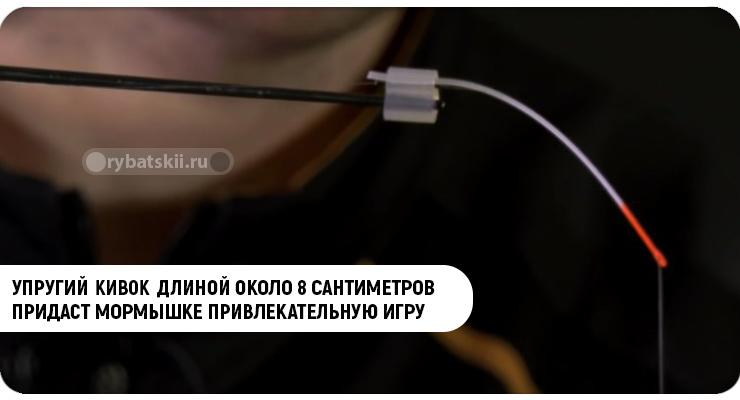
- fishing rod of the “balalaika” type;
- nod made of elastic material;
- monofilament fishing line with a diameter of 0.06–0.12 mm;
- jigs.
The balalaika fishing rod fits well in the hand and, thanks to the built-in reel, allows you to quickly change the working depth of fishing. A nod about 8 cm long is necessary to give the bait vibrations that attract fish. When fishing for roach, it is better to use miniature tungsten jigs with a small hook made of thin wire.
The bait is bloodworms or burdock moth larva. Fishermen also use reelless reels for roach, which work on the last ice.
DIY winter float
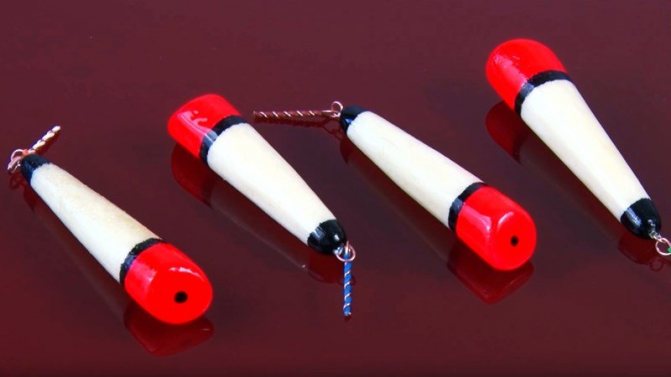
Making a winter float with your own hands is not difficult. You only need desire, a little time and hard foam with tools - a sharp knife, file or sandpaper. Making a float for winter fishing is even easier than the correct nod. If you do not have the necessary materials, you can modify the store float.
The process of making a winter float was well demonstrated by Dmitry Salapin in his video:
How to make a winter float:
- From a piece of hard foam we cut off the blank for the future winter float;
- Using a knife, we form a cylindrical shape of the float with a transition to a cone at the bottom;
- We make two loops from a single-core telephone wire, one of which is glued into the lower base of the float, and the other is suspended from it using the loop-to-loop method - this is the mount that secures the float to the fishing line;
- We paint the float with a permanent marker, varnish or paint.
A cylindrical winter float made of polystyrene foam can be compacted by rolling it between two planks. At the same time, the surface of the float becomes more even and smooth, and the small pores of the foam close.
The upper part of the float is cut obliquely so that during a bite on the surface, the float goes to the side - this way the bite is better visible.
Painting the float is useful not only for better visualization of the bite, but also so that the float freezes less and is easier to free from frozen ice.
Fishing rod for catching roach in the current
When catching roach in the current, fishermen use an under-ice version of the feeder. This gear includes:
- a fishing rod with an open reel and a brightly colored flexible tip;
- main monofilament line with a diameter of 0.15–0.17 mm;
- feeder feeder weighing from 10 to 30 g;
- leash with hook.
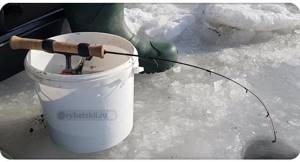
During the current, a winter feeder is used
The soft tip of the fishing rod acts as a bite alarm and allows you to see even careful touches of the roach bait. The reel used in this tackle makes it possible to quickly deliver the bait to the bottom and helps when landing large fish. The weight of the feeder is selected taking into account the current and depth at the fishing site. The length of the leash is determined empirically and ranges from 40 to 100 cm. Its diameter ranges from 0.08 to 0.14 mm. This rig uses size 18-16 hooks.
Winter float rods
For stationary fishing of peaceful and semi-predatory fish, the following types of gear are most often used:
- Winter fishing rod with float;
- Nodding ice tackle;
- Winter donks.
A separate publication on our website discusses the features of nodding equipment. Here we will dwell in more detail on the design of a winter float fishing rod. A float rod for winter fishing is more suitable for catching bottom fish, especially during periods of deep winter.
This is the main tool for winter fishing for bream and crucian carp. It’s more difficult with roach - the silvery fastidious fish at one time takes a stationary bait from the bottom, at another time it responds better to active play with a jig. Therefore, when winter fishing for roach, you need to be prepared to change your gear and fishing method.
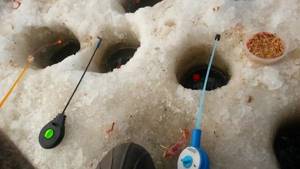
Fishing rods
For beginners, a simple float rod is an option to start your journey into the world of ice fishing; there is nothing complicated about it. After initial mastery, you should move on to more sensitive and difficult to configure float equipment.
Assembling a simple winter float fishing rod will not cause any difficulties. For gear, you can use any fishing rods with legs available in stores - standard fishing rods with reels, balalaikas, fillies and others. The main thing is that the tackle is stable on the edge of the hole and it is convenient for the fisherman to work with it.
To begin with, you can make a winter float fishing rod with your own hands literally on your knees - insert a piece of summer whip into a pair of wine corks, wrap a reel or reel of wire with electrical tape, and secure the legs of any design.
However, it is much more convenient to work with gear specially designed for winter fishing. Fortunately, they are cheap and available for purchase at any fishing store. In ice fishing with a float, the equipment itself is more important. Secondary storage and transportation device. Next, we’ll look at how to assemble a winter fishing rod with a float.
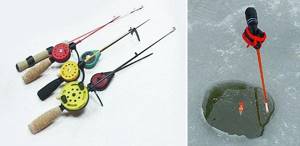
Standard float equipment
The simplest equipment for a winter fishing rod with a float.
- Line with a diameter of 0.1-0.14 mm;
- Small winter float;
- A jig or sinker with a hook.
The peculiarity of the installation and fastening of winter float fishing rods, in contrast to summer ones, is the overload of the equipment. The float becomes overloaded and sinks under the weight of the equipment. In the working position, it is set so as to be located 3-5 cm below the cut of the water surface. This is done to avoid freezing into the ice solder. Such a float rod without additional problems is suitable for catching fish during the active phase.
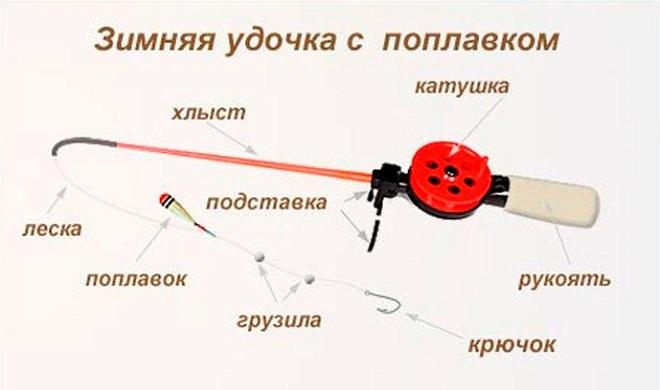
Tooling errors
Everything seems to be simple. However, such a simple fishing rod is just the tip of the iceberg. A picture you often see on reservoirs is a group of fishermen sitting. Some of them, with similar simple fishing rods, meditate for hours at the hole, emptyly waiting for a bite. Others run, drill, place five fishing rods, but don’t catch and curse.
If someone gets a fish, the crowd immediately rushes towards him and drills everything around him. Meanwhile, a couple of fishermen who, despite the apparent lack of bite and annoying drilling, take the fish out of the holes one by one, becoming the object of the obsessive interest of the surrounding losers. Well, for example, “Move the box, I’ll dig through here.” Let’s keep silent about the question “what are you fishing for?” Most likely, from the same bloodworm, from the same store.
The secret usually lies in the overall tactical approach and the correct equipment of fishing rods. And it’s not even a matter of the thickness of the fishing line or a specific jig. With a simple fishing rod, and one that has not yet been adjusted to a thin weight, the sluggish bites of the fish slowly feeding under the ice are not visible. And for these two, everything is fine. A simple, untuned float rig only works when the fish takes it greedily and boldly.
In other cases, which are the majority (especially in the middle of nowhere), a winter fishing rod with a high-sensitivity float is required. And here you don’t need any special equipment components. The same jigs and fishing lines are used. The whole secret is in fine tuning.
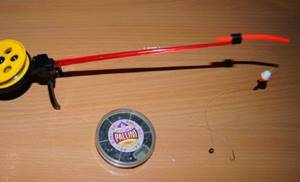
The right attitude
What do many anglers do? We hung a jig (a sinker with a hook) so that all the equipment would sink. With this approach, heavy equipment is attached to a light float with a low carrying capacity, many times greater than the ability of a piece of foam to lift it. It is important to understand that immersing the alarm under water is a secondary function of the gear, against freezing.
Beyond this point, some fishermen miss the main point. The submersible alarm must be adjusted correctly, and not sink to the bottom like a stone after heavy equipment. This flaw is expressed in the fact that people are catching around, and there are some attempts on the wrong fishing rods - the float twitches, the bloodworm turns out to be eaten when checked.

And under the ice in such a situation the following happens. The fish grabs the bait (sluggishly, slowly, it’s winter after all) and immediately spits it out, feeling a foreign object in its mouth (a jig) or the pressure of the fishing line on the lower lip due to the weight of the heavy sinker. If you simply hang a shot and place the hook on a leash (as in the summer version on a sunbed), then you can catch with such equipment, but only active fish that will boldly take the bait and swim away.
In winter, underwater inhabitants almost never do this (except for stray perch), moving sluggishly around the feeding area and slowly tasting and filtering edible particles. The winter float is designed primarily for catching fish from the bottom, respectively, with the same type of food. Therefore, the fishing rod adapts to such features. How to make a winter fishing rod with a float correctly? Let's look at how to properly load a float on a winter fishing rod.
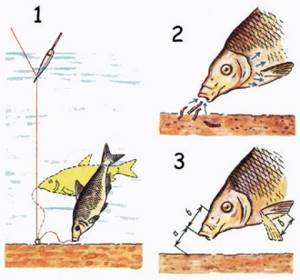
Fishing in the water column
Sometimes you need to fish not from the bottom, but in the water column. Roach, bluefish, sabrefish, and trout often “work” not from the bottom, but on high horizons. Accordingly, the usual winter bottom rigs are not suitable for such cases. For such fishing, you can use the usual summer method of loading the float without sinking it. However, in cold weather the float in the unloaded version will freeze. For winter rigs in deep water, a nod is more suitable. When fishing in the current, use a heavy sinker at the end and retractable leashes on the main line.

About jigs and fishing line diameter for a winter fishing rod
I never take the inscriptions on spools of fishing line for granted and I don’t advise you to either. If in doubt about the diameter, check it with a micrometer. The breaking load will be adequate for each diameter. You shouldn’t expect a miracle - that some fishing line will hold more than another with the same diameters and price category. I recommend using products from reputable brands. For example, this winter I equipped all my winter fishing rods with Shimano Ultegra fishing line - I have no doubts about its quality.
It is important to understand that the diameter of the fishing line itself does not affect the bite. For some, this statement may again seem strange, but believe me, it is true. Just a thin line provides better contact between the nod and the jig and allows the jig to sink faster. And the greater the depth, the more significant this factor is. That is, the connection is indirect: fish bite better on a small jig (they feel its weight less when they try to pull a bloodworm into their mouth with a stream of water), and to use such a bait, you need a thin fishing line, otherwise there is no other way.
How many times have I had situations on the Vileika Reservoir: you walk along well-fed holes with jig tackle, depth 6-7 m, fishing line ø 0.07 mm, jig 2.6 mm. If you try to switch to a slightly coarser tackle, empty bites immediately begin. Then you decide to “rest”, unwind the float tackle, where the fishing line is ø 0.12, or even ø 0.14 mm, and lo and behold, the fish (bream, roach, perch) begin to confidently peck at it! And all because the float rod is configured in such a way that the fish does not feel the weight of the load.
But let’s return to the jig tackle (after all, fish often prefer moving bait). The lower limit of line thickness is limited by the time it takes to land fish. And the fisherman’s task is to find a middle ground depending on the situation.
Roughly speaking, if small fish are caught in large quantities, then you can take a thinner fishing line - with it we will gain in the speed of lowering the tackle. And if single specimens weighing even 100 g are caught, then you can sacrifice a higher lowering speed, but gain in the speed of fishing. Moreover, a thicker line is, in principle, more convenient to use - it gets tangled less, you can pull harder if the line gets caught on a piece of ice, etc.
So that the jig bites
In order for the jig to bite , you need to purchase them in a normal assortment. This does not mean that you need to have “ovinka”, and “bug”, and “pellet”, etc. There is a universal form - in the form of an egg or a drop (we are not touching reelless fishing now). Unfortunately, good jigs are extremely rare in stores; athletes buy them mainly directly from craftsmen (among the Russian ones, the most famous ones are those from Tula ). A good jig has a hook of adequate thickness and size, as well as a cambric for passing the line through the body of the jig. The cambric should be thin. The best jigs are machined from solid tungsten rod. But if it’s an alloy or even lead, that’s also good, it doesn’t matter.
Something else is more important. Firstly, a good manufacturer should have a clear gradation in jig sizes, expressed in numbers: 1.8 mm, 2 mm, 2.2 mm, 2.4 mm, etc. This allows you to consciously change jigs, and not take “this one, bigger” or “smaller”. And if you find that in this situation a jig, say 2.6 mm on a fishing line ø 0.07 mm, works best, then next time you can start with the same tackle. Secondly, jigs of each specific size must have different hook numbers (if it is possible to order jigs from a master, this point is discussed in advance). Actually, the hooks themselves can be of the same model (for example, Gamakatsu 1050 is one of the best options for jigs), but differ in size.
After all, for example, it happens that we have to catch large fish in shallow water. This means that you need a small jig (passive fish bite on it more confidently), but at the same time, the hook must be of such a size that you can confidently fish it out without fear of going off. Or the opposite situation: the depth is 10 m, and there are hordes of ruffs standing there. You definitely need a large jig. But if it is equipped with a hook of proportional size to the body, then there will be many empty bites. And with the transition to a smaller hook, the ruffe will begin to confidently swallow the bait, despite the large, up to 5 mm, jig (of course, provided that the ruffe is active).
What determines the selection of a winter fishing rod and its equipment?
I have already mentioned some conditions on which the selection of a winter fishing rod for ice fishing in winter depends, and some are probably not so obvious. So, the choice of gear depends on what kind of fish bites (size and type), on the number of empty bites, on the depth, on weather conditions and, finally, on the tasks that the fisherman faces. Let's talk in more detail about each of these aspects.
Fish size. Everything seems to be simple and clear here: a big fish means a thicker line, a larger jig. But this is only if there is a purposeful catching of large fish, which, for example, happens to me quite rarely.
More often than not, large fish are a “bonus” when catching small or medium-sized fish. And here you have to look for a compromise depending on how likely the “bonus” bite seems to be. After all, if you use too thick a fishing line (read: a large jig), you won’t be able to properly get bites from the main (small) fish. But the “bonus” may not arrive at all. In principle, if you have a certain skill, you can catch large fish with thin tackle - for example, with a fishing line ø 0.06 mm, I had to pull out 1 kg of bream and 0.5 kg of perch. But this, of course, is an extreme.
Type of fish. This factor sometimes plays a significant role. After all, for example, a 300-gram roach or humpback perch resists more strongly than a bream of the same size. A half-kilogram bream, and from great depths, can be taken even with the thinnest fishing line ø 0.05 mm. And with “bonuses” of other types, the chances are minimal.
And one more moment. For roach and bream, especially if the fish bites while lowering or “on the stand,” rapid shaking of the jig is absolutely not necessary. This means that there is no need for a thin fishing line (i.e. to ensure the clearest possible contact between the nod and the jig). For example, you can take a fishing rod with a 2.4 mm jig and a line ø 0.08 mm, and successfully catch roach from a depth of 5 m.
But perch often requires active play, which can only be achieved when every movement of your hand is transferred to the jig. This means that a 2.4 mm jig in combination with a fishing line ø 0.08 mm is no longer suitable for this depth. You need to either take a thinner fishing line with the same jig, or use a larger jig if the bite allows it. By the way, ignorance of this nuance let me down at the very first world championship in which I had the opportunity to participate, which was in 2007. The competition took place on a shallow forest lake in north-eastern Poland, and the main fish in the catch was a small roach.
In the first round, I guessed the place where the fish stood, and, as it turned out, I drilled holes in the most fishy part of the zone. The roach began to peck, “like a machine gun.” But I’m used to the fact that here in Belarus perch bite from such depths, and, of course, not at such a frantic pace. I fished with fishing lines ø 0.06-0.07 mm and ended up tangling several fishing rods, and also got the jig broken in the working hole itself, after which it “died.”
If I were now, 8 years later, in that situation, then, of course, I would have fished with ø 0.08-0.09 mm, but then, due to the gear, I didn’t catch several fish to the first place in the zone and became second. Which, of course, was also a great result. True, in the second round I “flew away”, but not because of the gear, but because, having been drawn into a zone with few fish, I tried to catch roach with the usual “perch” tactics - actively moving and drilling, while it was necessary to identify the fishing area and quietly feed it. Well, okay, we've digressed from the main topic.
The size of the jig and the implementation of bites. Empty bites can occur for various reasons. For example, a fish is not satisfied with two bloodworms on a hook - you need one, and so that it does not hang down, but is impaled in a ring. Or today it prefers not large, but food bloodworms. Or the hook on the jig is too big. But still, more often than not, the presence of empty bites is a sure signal that you need to use a smaller jig (and therefore a thinner line). Of course, if for every 10 hooks there are 2-3 idle hooks, and the remaining 7-8 are effective, then this is not bad. But if half of the bites are empty, something needs to be done.
Watch your aquarium fish as they take food. They do not bite him, do not swim at him with their mouths open, but drag him in with a stream of water. The inhabitants of natural reservoirs also eat. And if the food offers resistance that is not natural for its size, then this may cause suspicion in the fish. Or rather, this: if there are a lot of fish and they are active - there is a rush in the school to see who will be the first to satisfy their hunger - then a heavy jig can also “roll”. But when the fish is “comatose”, then the chances of catching it with a heavy jig tend to zero.
And this also happens. You come to a well-fed hole, lower the relatively coarse tackle - you catch a few active fish, and that's all. You wind it up, lower the more delicate one - and, lo and behold! - you take out a few more fish that you might think weren’t there...
A large jig, as you understand, is good in terms of ease of lowering. But there is also an opinion that the fish hears its vibrations from great distances and therefore approaches the hole faster. In my opinion, this is not significant. And if fishing takes place using bait, then it doesn’t matter much - the fish is already coming to the point. With perch, it happens that the first 2-3 fish in a new hole have to be “tortured”, and then the bite increases - the fish hear a fuss at the point, a stir appears in the school, and the perches begin to take, as they say, on the fly.
Depth. The thicker the water, the larger the area of contact with the fishing line. And the thinner the line, the smaller this area, and the less friction is created. Let's say we find ourselves on a lake evenly populated by perch with an average weight of 40-60 g and it bites on a 2.4 mm jig (there are many empty bites on 2.6-2.8 mm ones). We start fishing from a depth of 1 m. Here you can use a fishing line ø 0.10 mm. This is also good for ease of fishing. After all, as you know, the shallower the depth, the less the line absorbs and the higher the risk of breakage.
We move to a depth of 2.5-3 m. Here the same jig already refuses to play on a fishing line ø 0.10 mm. And at ø 0.07 mm it works as it should (it is clear that the nod does not slow down). We move to a depth of 6 m. Here even ø 0.07 mm is too thick, the jig sinks for a long time and does not want to play. Of course, if shallower holes are working, then it is wiser to return to them. And if not? Then there is only one way out: fish with fishing lines ø 0.05-0.06 mm. You can also try to lift the perches into the water column or even under the hole; I continuously throw pinches of small bloodworms into the hole. This trick sometimes works, for example, on Lake Michurinskoye, near St. Petersburg, where the Baltic Cup is held every winter.
There is one more technique, which, however, is prohibited in a sports jig, but nothing prevents you from using it for amateur fishing. The point is that half a meter above the jig, one or more small lead “pellets” are clamped onto the fishing line. Thus, we can quickly deliver a small jig to the depths, which the fish will bite on more confidently. For catching perch, such equipment is not particularly relevant, but for white fish, when the bites go down smoothly, it works just fine!
Other factors. Sometimes in strong winds you have to use heavier jigs (even if sacrificing the realization of bites), because otherwise it is generally impossible to recognize the bite - the wind shakes the nod so much that nothing is clear at all. But in this case, I would not recommend increasing the diameter of the fishing line. Of course, a thick line gets tangled less, but it also sails stronger. This means that the effect of increasing the weight of the jig is lost.
The choice of gear also depends to some extent on why we come fishing. If you just want to relax, then maybe there is no point in getting carried away with ultra-thin fishing lines and small jigs. Let us not catch a few capricious fish - sometimes this is not the most important thing. If you are interested in maximum results, then you should use the above tips and fish with harmonious gear.
These articles may interest you
- Simple knots in fishing
- Ice fishing on Zaisan in spring
- Spinning rod - proper care
- Sensitive spinning rod tips
- Spring fishing for pike perch
- Spinning universal tackle for fishing
- Fishing in the region:
- Fishing during the seasons:
- Fishing:
- Our gear
Fishing rods for the current
On a small current, all the winter installation options discussed above are used, it’s just that the overall load of the equipment is greater. The tackle must resist the flow. If the nod does not hold and the float is pulled under the ice, use equipment with a retractable leash or a sliding olive sinker. A winter fishing rod with a sliding sinker does not register subtle bites on the rise. However, in a current this is not so important - fish in a stream always bite more sharply and actively. The bite is expressed not in the rise of the float or nod, but in twitching downwards. Read more about winter equipment for fishing on currents.
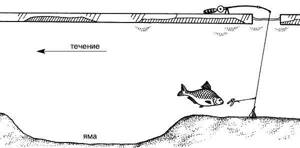
Loading the float
Even the simplest winter float equipment needs to be shipped correctly. To properly equip a winter float rod:
- The size and carrying capacity of the float with the weight of the jig (sinker) is carefully selected.
- The weight of the equipment should slightly exceed the carrying capacity of the float. It is necessary that the equipment sinks slowly, having a barely noticeable overall negative buoyancy.
- The winter float is loaded in advance, at home in a container with water.
- Each weight of float equipment has its own setting.
The setting process is expressed in the selection of a load in which the float barely stays on the surface (the upper part protrudes from the water, when pressed with a finger, it sinks and floats up very slowly). After finding this position, we place the load (jig) a little heavier so that the equipment sinks slowly - this will be a working option.
This thin winter float works in still water, weak currents and at depths of up to 8 meters. For places with a current and a depth of more than 10 meters (for bream, for example), special equipment is used (more on this later).
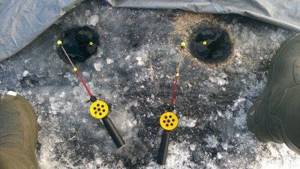
Floats
Loading and rigging of winter floats for ice fishing in any variations is carried out according to the principle described above, regardless of the gear configuration. There are many options for making floats for winter fishing - barrels, cigars, with a through fastening through the body or a cambric for sixes. This element of winter equipment itself is simple. What is more important is not the design itself, but its correct loading. An article about floats for winter fishing.
Composite floats and petals
With the most careful bites, the small ball float rises only a centimeter or two. And this can simply not be noticed. To make the float tackle even more sensitive, composite structures are used. The components represent several foam plastic bodies (two or more), hingedly connected to each other.
In this case, the largest body is located at the bottom, and then upward in decreasing load capacity. The principle of compensation works when the load is correct. When biting with a small amplitude of lift, only the upper small body is shown at the top. The big one is still in the water, holds the equipment and unloads it.
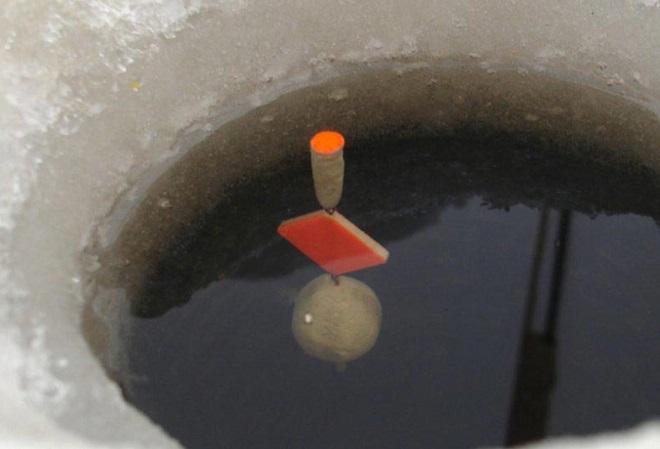
Loading a winter double float (and triple) is carried out according to the same principle. The equipment is selected slightly heavier than the load-carrying capacity of the joint. In the working position, the fishing rod is installed so that the upper body does not reach the surface of the water 1-2 centimeters. In simple composite floats, the bodies are attached in series. However, there are also even rarer designs - floats with petals. Their functions are the same.
It is advisable to use composite floats for deep fishing for bream and crucian carp - up to 8 meters. They are usually larger and therefore have a greater carrying capacity. The rig contains a heavy jig or a light jig with a higher sinker. The most popular option is the main sinker plus a sub-sink. Naturally, the load is adjusted so that with the main load the equipment retains minimal buoyancy, and when added, the auxiliary gear slowly sinks.

Equipment for standing water
- Installation and equipment of a winter fishing rod is not done once and for all. This is one aspect of ice fishing that requires constant monitoring and modification if necessary.
- A constant readiness to experiment and use other mounting options is what distinguishes a successful angler from a useless meditator over the holes. Therefore, no equipment is taken for granted - today it works, but tomorrow it won’t.
- Close attention should be paid to the little things - place the feeder 3 or 5 centimeters from the hook, the pendant 7 or 10 from the bottom jig, and so on. Often such little things in the equipment of fishing rods separate successful fishing from unsuccessful ones.
- There is no need to sit over the hole if it doesn’t bite. You need to take some tactical actions (change the horizon, move to a new place) or experiment with editing, try to catch not by standing, but by active play.
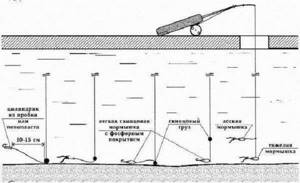
One hook or jig
Basic winter equipment - use one jig at the end of the fishing line or a hook with an undercut (small pellet of 3-5 cm). Naturally, in any option, the installation is adjusted to the load capacity of the float or the elasticity of the nod.
Jigs and hooks, depending on the type of fastening, are tied with standard winter fishing knots - a regular self-tightening loop, palomar, clinch. Particular attention is paid to tightening jig knots on fishing rods for fluorocarbon fishing line, which is characterized by rigidity and weakness to bending.
The knots are wetted and tightened carefully, in one slow movement, increasing at the end. After tightening, there should be no constrictions or damage left on the fishing line at the knot. After intense fishing, it is advisable to re-tie all the rigs and update the knots.
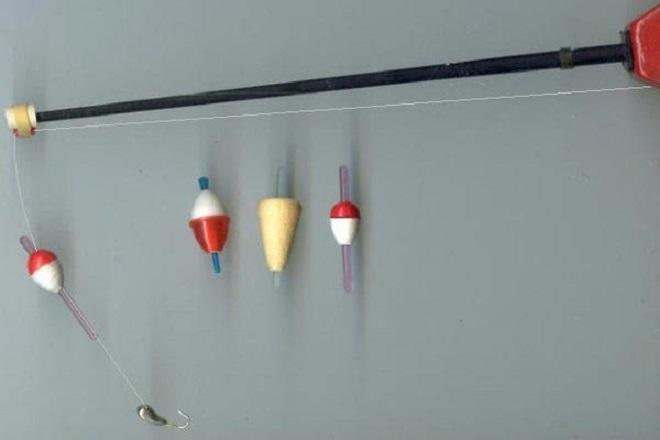
Two jigs by a steam locomotive
Often options that work well include placing a second hook or jig in the fishing rod assembly. Usually the provocateur is smaller. You can place the second hook in the rig in various ways:
- Steam locomotive;
- In sliding version;
- On a leash.
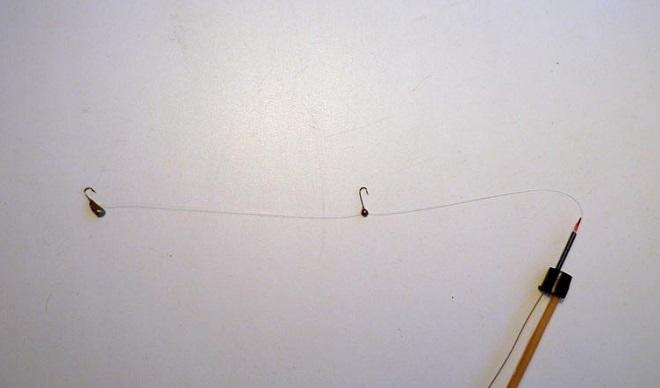
Such winter pendants work great against roaches and bream. One of the equipment options is a steam locomotive. A large jig is tied below, and above it - a smaller bait, hook or fly directly to the main fishing line tightly. The tip of the hook should point upward. To tie the second jig, a palomar knot is used (based on the principle of a drop shot from a spinning rod).
When tying, you can get two options - with the sting down or up. You should practice so that the sting is directed upward. It depends on which side of the hook ring the loop is threaded when forming. The disadvantage is that the upper bait often catches on the lower edge of the hole (if the fish sits on the main jig).
Palomar knot for hanging a hook or jig with a locomotive ring

Jig knot with hole
Sliding hook
A hook or a light jig can simply be put on the fishing line before the bottom load, limited on both sides with silicone stoppers. The stoppers also move apart by 2-5 cm, ensuring free movement of the bait up and down.
Such a provocateur works great when playing with tackle, since the light hook returns more slowly to its original position. These vibrations of the bait perfectly attract different winter fish. A small hook with a bloodworm or a small light-accumulating plastic jig works well in winter.
During fishing, the stoppers move to find the desired working horizon. Sometimes it bites better at the very bottom, at other times – half a meter from it. When hooking a fish by the upper hook, the stoppers move down, eliminating the possibility of the second bait catching on the edge of the hole when fishing.
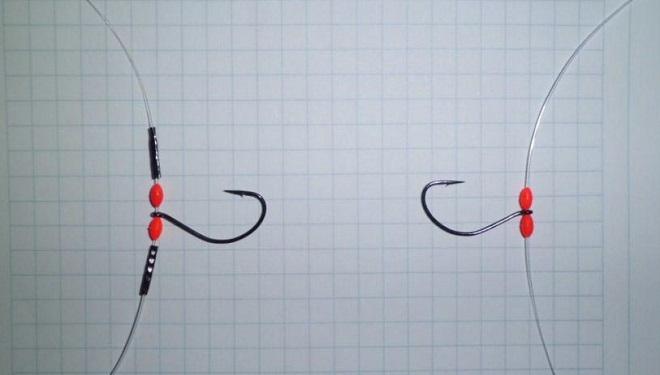
Upper suspension on a lead leash
A common equipment is a winter fishing rod with two hooks. Often anglers simply make two equal leashes with hooks or jigs of the same size. However, such installation in winter is impractical. The leashes will only get tangled and interfere.
- A much more catchy rig option is to place a small leash with a hook or light jig above the main bait. Such equipment of a winter fishing rod for catching roach often brings results when conventional mono rigs do not work. Such a winter diverting leash for a fishing rod sinks more slowly than a heavy jig that has already reached the bottom when lowering the tackle into the hole or twitching.
- And often this factor becomes decisive. Exactly the same provocateur is tied in a hook rig. Just below, instead of a jig, there’s a grappling hook and a hook. The leash on a winter fishing rod is placed 7-15 cm from the lower bait, 5-7 cm long. This scheme works well if there is a layer of soft or soft material at the bottom, into which the lower bait simply falls into it.
- A leash for equipping a winter fishing rod with two hooks is tied so that the direction of the fishing line is from bottom to top. Then it will not get confused with the main monofilament, but will direct the additional suspension to the side. This type of equipment can be achieved in several ways.
The usual and easiest knot. On the main line we tie a regular knot, preferably a double or a figure eight, and pass the leash into it (from top to bottom). We tie the leash under the knot with a regular fishing loop. This knot can weaken the main line.
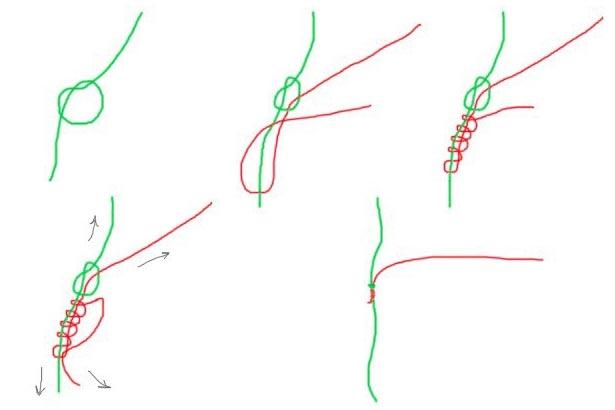
Fishing loop through a knot
The greener is simple and reliable and does not weaken the line.
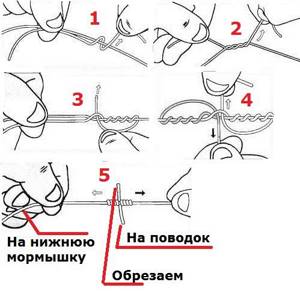
Greener
Bloody Knot
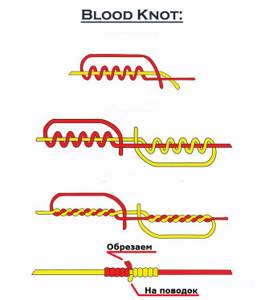
Blood Knot
The Uni knot is recommended for fluorocarbon line. This fastening option is sliding along the main line.
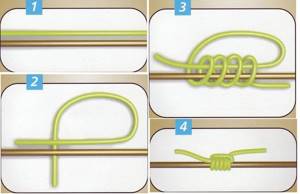
Uni

Trout rig with wire outlet
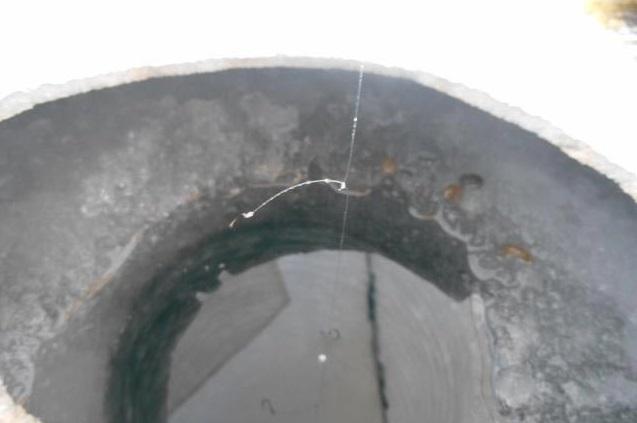
Approximate result
Suspension below the main jig
When playing with bait or on thick mud, one of the solutions is a leash with a hook or a light jig, tied directly to the shank of the main bait. In this case, you need to tie the leash to the fore-end before installing the jig. This is necessary so that the leash knot does not move down the hook of the jig when fishing for a fish caught on it.
This kind of fishing rod rig is rarely used for winter fishing, but sometimes it helps out when there is no bite, for example, when targeting passive perch. The presence of a light suspension below the main one (Finnish method) is used for winter perch also on spinners and balancers, when the lower tee is changed to a short leash with a hook and decoration on it.
Rocker
A rocker rig is often used for bream. The rocker itself in this case is made special, lighter than on summer donks. The most sensitive equipment options are sliding ones. An article about the use of a rocker in winter fishing.
